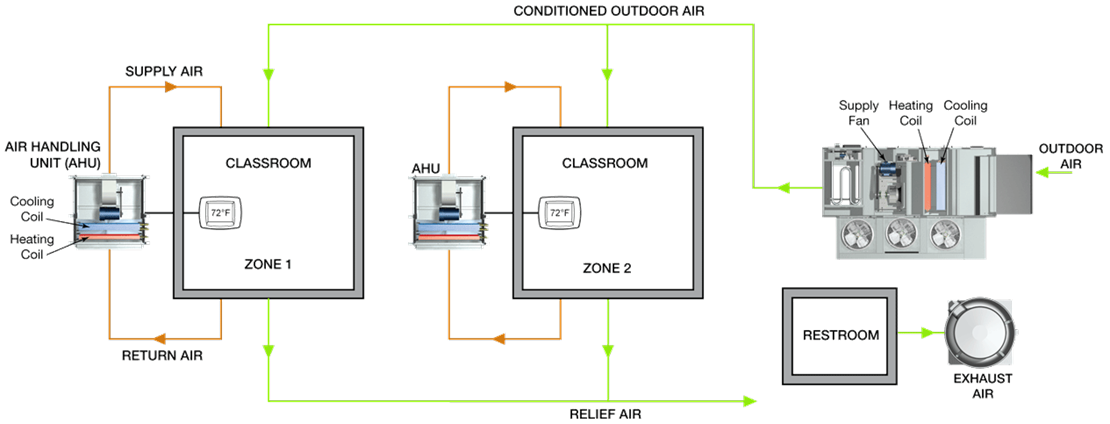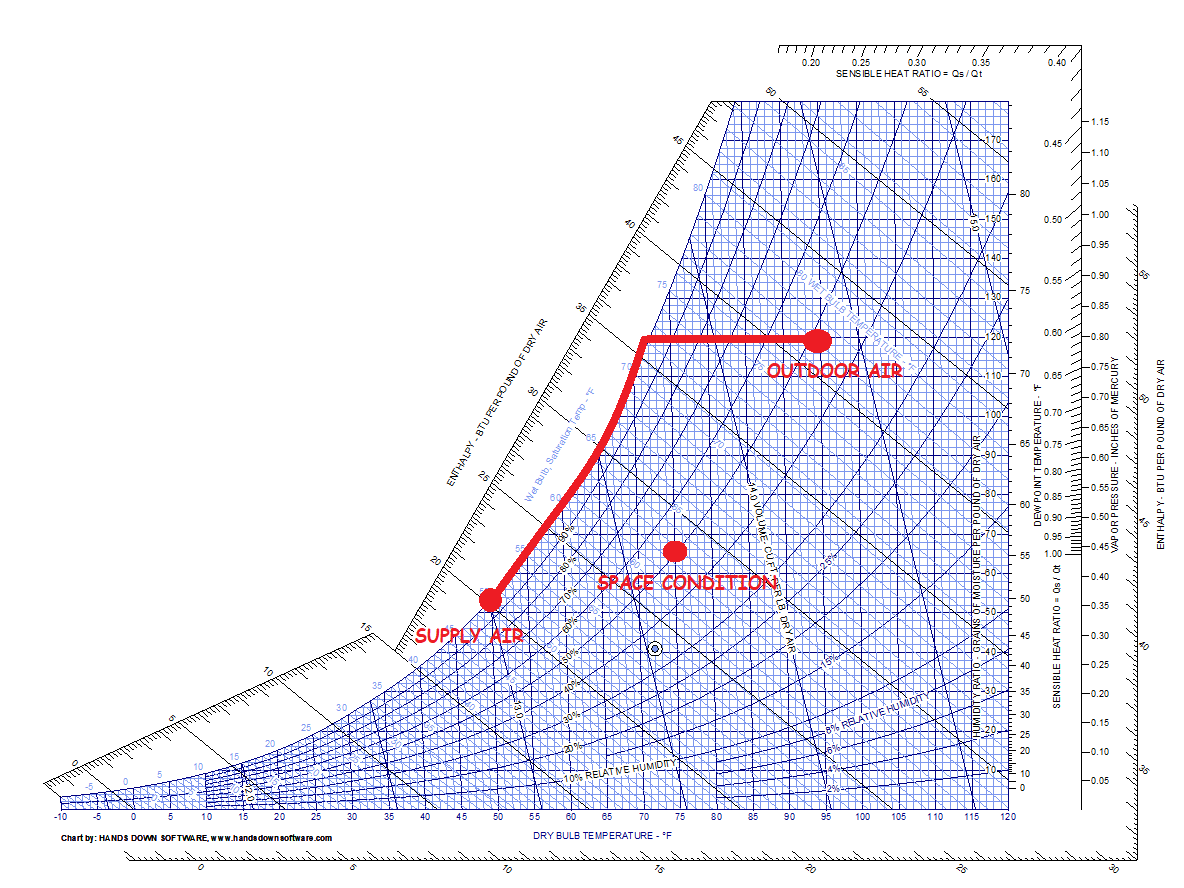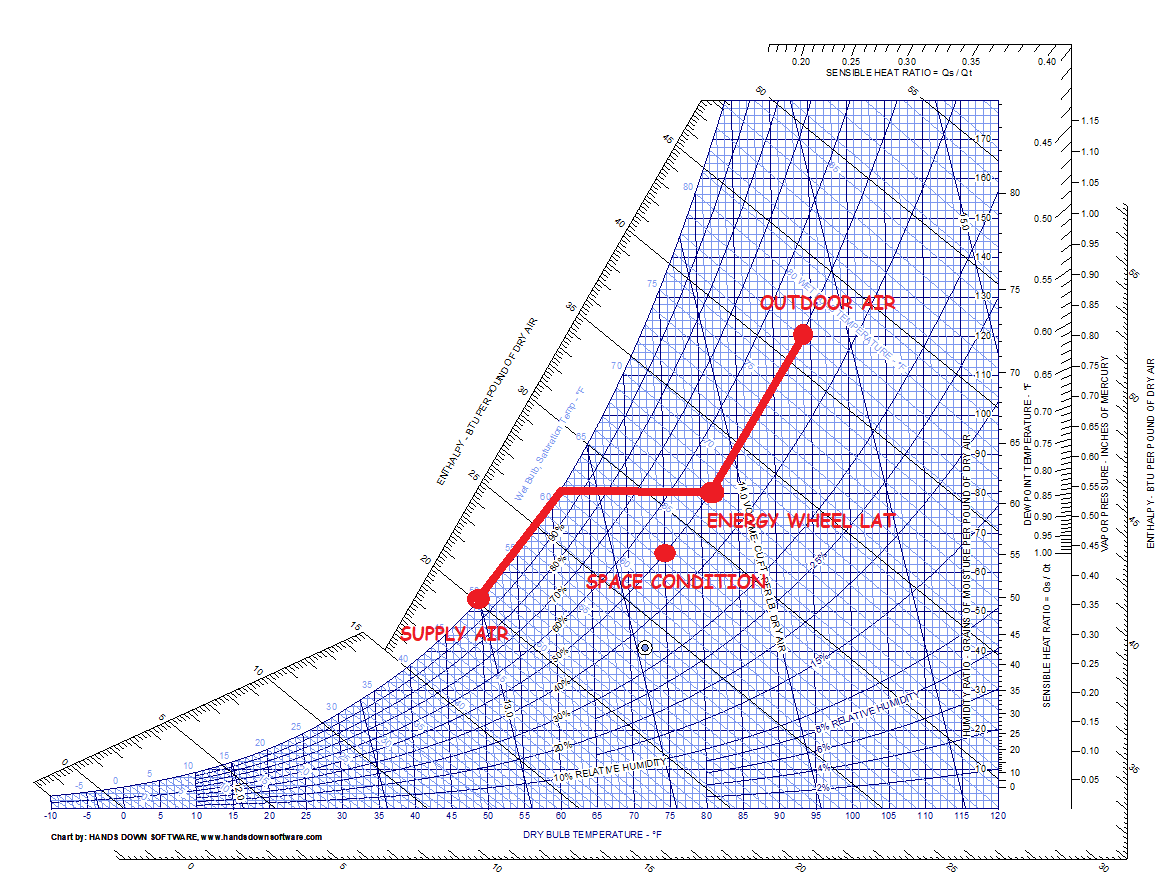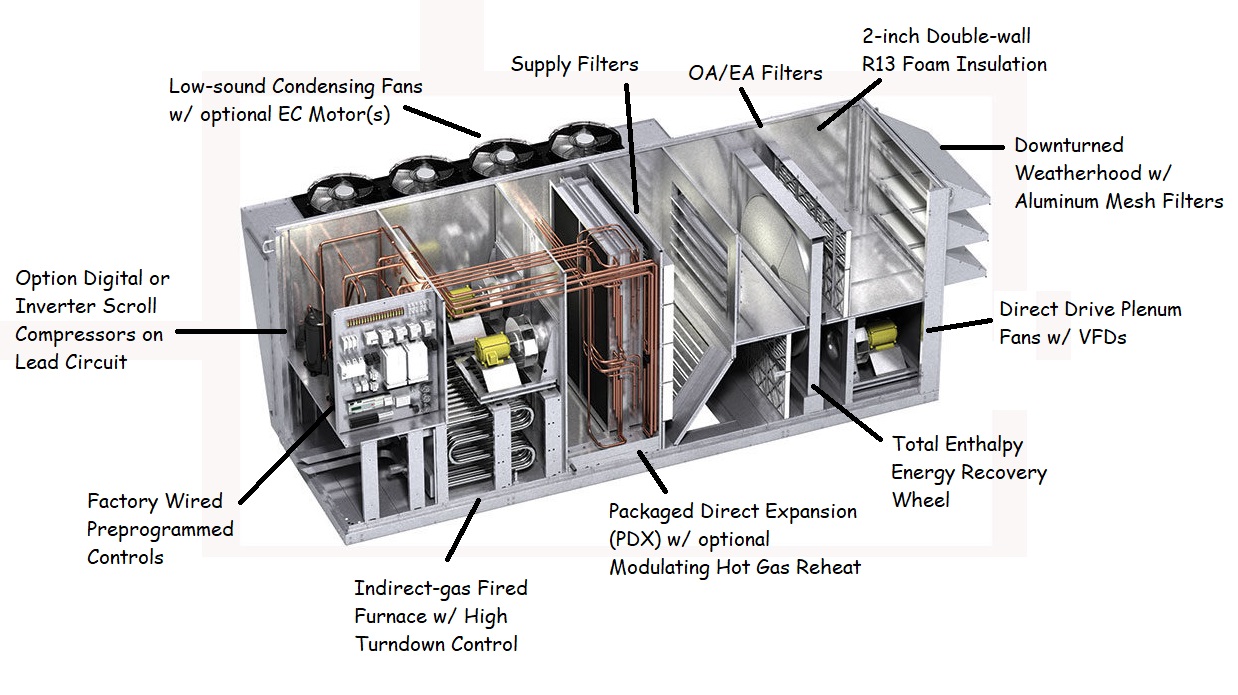Like a bird, flying high above the roof line, we will be taking an elevated perspective of dedicated outdoor air systems (DOAS). Fairly complex in nature, we will describe where and why they are used, along with models and features that are available to satisfy your system requirements.
What is DOAS?
A DOAS system uses a centralized unit that provides 100% outside air that can be delivered directly to the occupied zone or to local units (ex. Air handler) serving multiple zones. The DOAS unit is designed to provide dehumidified ventilation air, decoupling the building latent load from the space sensible load. These units can also provide heated outside air during the colder months.
DOAS units are commonly used in the following applications:
- Education
- Healthcare
- Office Space
- Hotels
- Assisted Living
A school is one example of where a DOAS system can be used. The figure below shows two classrooms being fed conditioned 100% outside air from a DOAS unit. Each classroom is controlled by an air handler that sensibly regulates the temperature off a thermostat set point. The air from the classroom is recirculated through the air handler and some of the air is relieved out of the space.

Figure 1: Depiction of DOAS application. Image taken from Greenheck blog dated August 2021. (Click image to see full-size version.)
Dehumidification Process
During the dehumidification process, hot & humid outside air is cooled sensibly through an evaporator coil. This process has a leftward movement on the psychrometric chart, approaching the saturation curve. At these conditions, the air is condensing, stripping the moisture. DOAS units are designed to deliver dehumidified outdoor air that is dryer than the space condition so leaving evaporator coil conditions will range from 50-55 degree dry/wet bulb to properly dehumidify the air. Depending on the application, this air can be discharged to the space/system, or it can be reheated back up to a neutral condition via hot gas reheat coil located within the unit.

Figure 2: Depiction of outdoor air example on psychrometric chart. (Click image to see full-size version.)
Energy Recovery in DOAS
Adding a total enthalpy wheel for energy recovery in a DOAS unit will help reduce the mechanical cooling (and heating) required on the building. These devices are meant to pre-cool/dehumidify the hot & humid summer air and pre-heat the cold & dry winter air. Not all applications require nor should utilize energy recovery, but those that do will see an average savings of 3-4 tons per 1000 cfm in their system design.
DOAS units can utilize an enthalpy wheel manufactured out of aluminum or polymer materials. Although there are differences in construction, they provide the same enthalpy recovery ratio (aka effectiveness) and exhaust air transfer ratios (cross leakage).
|
Wheel Material |
Aluminum |
Polymer |
|
Wheel Thickness |
4 – 12” |
1 – 4” |
|
Construction |
Single Piece |
Segmented |
|
Desiccant |
Molecular Sieve |
Silica Gel |
|
Enthalpy Recovery Ratio (%) |
70 – 80 |
|
|
Exhaust Air Transfer Ratio (%) |
3 – 5 |
|
Table 1: Energy wheel comparison.
When specifying energy recovery equipment, it is crucial to schedule energy wheel performance. This includes summer/winter design conditions, leaving wheel air temperatures, as well as a minimum enthalpy recovery ratio (%). Scheduling this information helps ensure that the equipment bid and purchased meets the original design intent and functionality.
Dehumidification Process with Energy Recovery
Using an enthalpy wheel will change the dehumidification process. Instead of the evaporator coil initially cooling the air, the energy wheel will help reduce the sensible and latent energy, showing a diagonal movement on the psychrometric chart. The leaving air temperature from the wheel is dependent on how effective the device is so that will dictate the distance traveled. After the air leaves the energy wheel, the evaporator coil can continue to dehumidify the air.

Figure 3: Depiction of outdoor air example with energy recovery on psychrometric chart. (Click image to see full-size version.)
Efficiency in Motion
Choosing the right components and control sequences is crucial to not only meeting design, but efficiency requirements.
Low sound condensing fans feature a swept blade fan design. This blade design helps reduce sound power levels as well as improves efficiency ratings. EC (electronically commutated) motors are available on the lead or all condensing fans, which allow for modulating head pressure control.
High turndown furnace control allows for seamless modulation between 6 and 100% operation, decreasing operating costs, minimizing cycling, and providing precise temperature control to the space.
Digital or inverter scroll compressors are variable speed options that help provide precise temperature control. Digital scroll compressors utilize a motor that runs continuously, adjusting scroll speeds while an inverter scroll compressors utilizes a VFD (variable frequency drive) that adjusts motor speeds, leaving the scrolls in a fixed position.
Economizer control for energy recovery allows for outside air to be supplied without any tempering. Stop wheel, a bypass damper, or modulating wheel, are ways to allow that operation.
Factory programmed controls provide standalone functionality or communication to a building management system (BMS). The “brains” of the unit are designed to control the intricate operations required of these units without any outside interjection.
Efficiency Ratings
When designing DOAS equipment, ISMRE (Integrated Seasonal Moisture Removal Efficiency) is the efficiency rating that you will need to look for, not an EER or IEER value. AHRI-920 is the standard for ‘Performance Rating of DX-Dedicated Outdoor Air System Units’ and specifies the testing/rating requirements and minimum performance for DX-DOAS equipment by specifying minimum ISMRE values.
The ISMRE is a dynamic test that represents how well the DOAS unit dehumidifies the air over the entire season. Equipment is tested at four different conditions (A, B, C, D). Each condition has a specified condenser entering air temperature (dry-bulb) and a different set of evaporator entering air conditions (dry-bulb/wet-bulb).
EER/IEER per AHRI Standard 340/360 is a static test that also depicts how the unit operates at different times of the year, however, the air conditions entering the evaporator coil are the same at all four conditions. This rating DOES NOT address the process of dehumidification and therefore is not a good measure of dehumidification efficiency.
Learn more about the differences between ISMRE and EER/IEER.
DOAS from Brucker
Brucker can provide Greenheck DOAS models RV (rooftop ventilator) and RVE (rooftop ventilator with energy recovery) for applications ranging from 500 to 18,000 cfm. DOAS units come in similar shapes but can vary in size, based on the capacity required. When specified with energy recovery, they will have a total enthalpy wheel, supply, and exhaust fan(s). When specified without energy recovery, they will have supply fan(s) and have an option for a powered exhaust fan(s). Greenheck DOAS units can also be used in applications that require higher percentages of outside air, allowing 20-100% of the outside air to the space via a modulating OA (outside air) and recirc air damper.
Inside a Greenheck Model RVE DOAS Unit
|
Heating Options |
Cooling Options |
|
Hot Water |
Chilled Water |
|
Indirect Gas Fired (up to 16:1 turndown) |
Split Direct Expansion (DX) |
|
Electric Heat |
Packaged DX (up to 70 tons) |
|
Air-source Heat Pump (5-30 tons) |
|
Table 2: RV/E heating & cooling options.
Learn more about Greenheck DOAS units.
Selecting DOAS Equipment
DOAS selections can be made through Greenheck’s CAPS (Computer Aided Product Selection) and eCAPS software. CAPS software needs to be downloaded to your computer and provides detailed product selections with full submittals, drawings, and equipment schedules. eCAPS is a web-based software that does not require any download or log-in and provides quick and easy selections in a simpler form. Both programs have AutoCAD and Revit content and can generate equipment schedules.
Learn more about CAPS/eCAPS Software.
Although we were just “flying high” to get that broad perspective of DOAS, you can always take a deeper dive into these products by contacting your local Brucker sales representative for more information on Greenheck models RV and RVE.
References:
1. Pearce, N. (n.d.). Greenheck blog |. Greenheck. Retrieved February 23, 2022, from https://www.greenheck.com/resources/blog/blog-post/fresh-air-from-greenheck/2021_08_23/what-you-need-to-know-about-doas-and-the-new-efficiency-ratings
2. Dedicated Outdoor Air Systems – Greenheck-USA. Greenheck. (n.d.). Retrieved February 23, 2022, from https://content.greenheck.com/public/DAMProd/Original/10002/rv_rve_catalog.pdf


Recent Comments